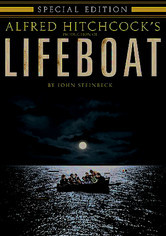Lifeboat-1944
Director Alfred Hitchcock
Starring Tallulah Bankhead, William Bendix
Scott’s Review #1,020
Reviewed May 6, 2020
Grade: A-
Alfred Hitchcock, well-known for big, bouncy, suspenseful productions, creates a stripped-down, intimate story of adventures while adrift on a survival boat, leaving plenty of tension and peril.
Lifeboat (1944), now teetering on extinction from memory save for fans of the director, deserves appreciation and respect for the brilliant direction and outstanding cinematography alone.
The film was met with controversy and some derision for sympathetic depictions of a German U-boat captain (Walter Slezak) amid the horrors of World War II.
Events begin in the middle of calm Atlantic Oceanic waters after a cruel battle results in a German U-boat and a British/American ship sinking each other, leaving fewer than a dozen civilians and service members to survive in one Lifeboat.
The haughty, glamorous columnist Connie Porter (Tallulah Bankhead), clad in the finest fur coat, is irritated by a run in her stocking, a travesty in her mind.
She is slowly joined by other survivors, including a young British woman with a dead baby, a steward, a U.S. Army nurse (Mary Anderson), a wealthy entrepreneur, and other people from most walks of life.
Lifeboat plays out like a more cerebral version of a disaster film. Think- a brilliant man’s version of The Poseidon Adventure (1972), said with love since it’s one of my favorite films. But with Lifeboat, darkness and a sense of sadness are missing from the 1970s’s more lightweight disaster films.
The black-and-white camerawork helps tremendously, as do the mist, the rain, and the intense beating sun. The weather elements play an essential role, as do the characters themselves.
Speaking of characters, the individuals are plentiful and diverse, ranging from British, American, Black, German, wealthy, and working-class to eventually dead and alive with a gruesome leg amputation taking place mid-stream.
Each is well-written and exhibits fear, bravery, and suspicion of the other’s motivations. The German captain communicates with Connie in his native tongue, causing confusion among the other survivors.
Events would hardly be complete without a good melodramatic romance, and it is a treat to see two formulate. Connie and handsome John (John Hodiak) share a love/hate relationship, clearly from opposite backgrounds, while the more stable Alice and Stanley (Hume Cronyn) even decide to marry!
Genteel Alice reveals a marriage and an affair to Stanley, uncovering the layers and complexity of the character.
My favorite character is Connie, and Bankhead is a pure delight in the bitchy, no-nonsense role. She enshrouds the camera from the first scene.
Reminiscing about Bette Davis, the actress has a similar composure, stance, and trademark cigarette but slowly reveals her insecurities and desperation.
What fun she is to watch!
A tender and poignant scene occurs at the end of the film and is lovely to witness, especially given the tumultuous time of the mid-1940s. A drifting young German soldier attempts to board and shoot at the survivors but is apprehended.
Disputes occur, but instead of shooting or casting the lad overboard to drown, he is saved and presumably provided food and water. Does he inquire why they don’t kill him? The message is powerful and anti-war.
The direction methods are brilliant, and they look as realistic as possible in 1940s cinema, where CGI was decades away. Hitchcock had me fooled as I bought lock, stock, and barrel that the Lifeboat was in the middle of rough and murky waters instead of a Hollywood studio tub.
The creative method of gathering so many characters into one shot wonderfully and effectively provides a claustrophobic feel, as the lack of food and drinking water causes hysteria and emotion.
The one-set approach is marvelous and perfect for the film’s specific storyline.
After decades of underexposure and playing second or third fiddle to other Hitchcock masterpieces, Lifeboat (1944) is finally getting some notice and acclaim. The trend continues here, as the film contains enough frights and perils to keep anyone guessing which characters will sink and which will swim.
Although it may not be the best watch on a cruise ship or other watery surfaces, the escapade will delight fans of classic black-and-white thrill cinema.
Oscar Nominations: Best Director- Alfred Hitchcock, Best Original Story, Best Cinematography, Black-and-White
